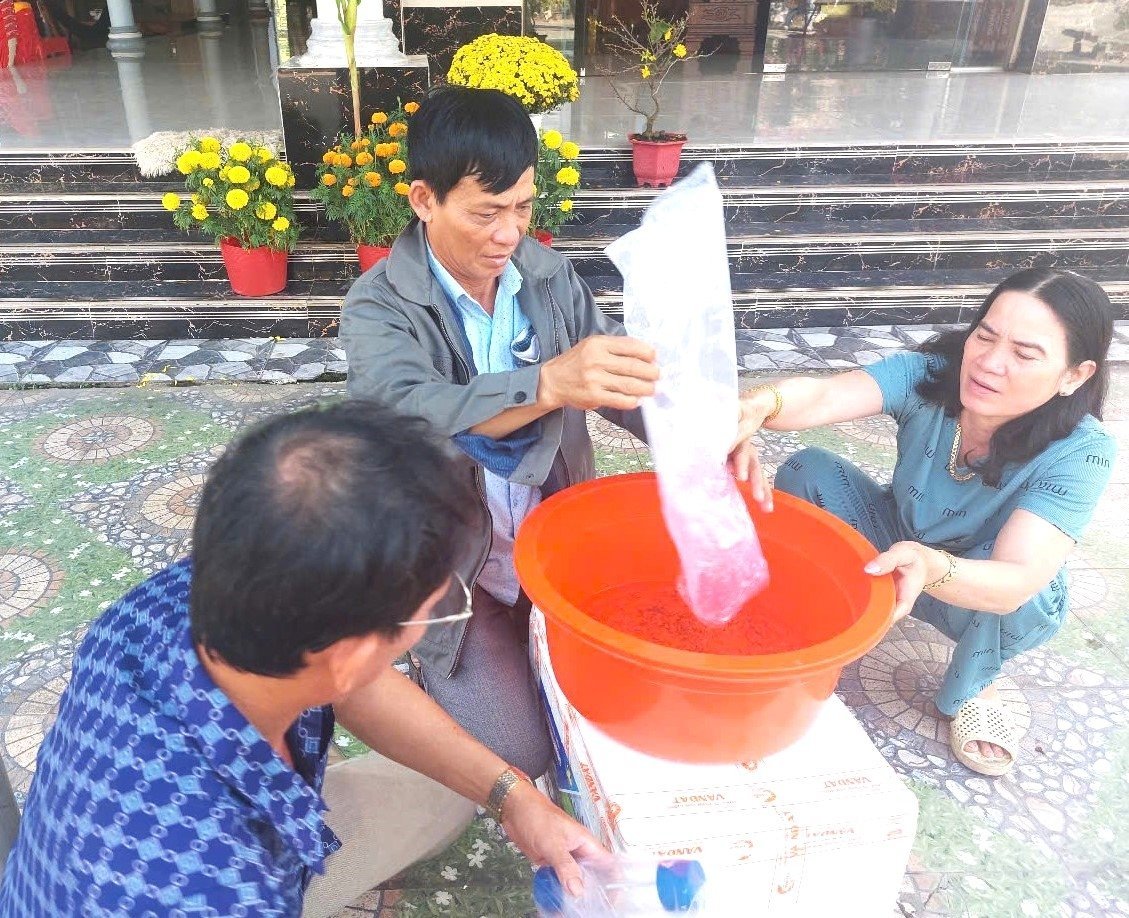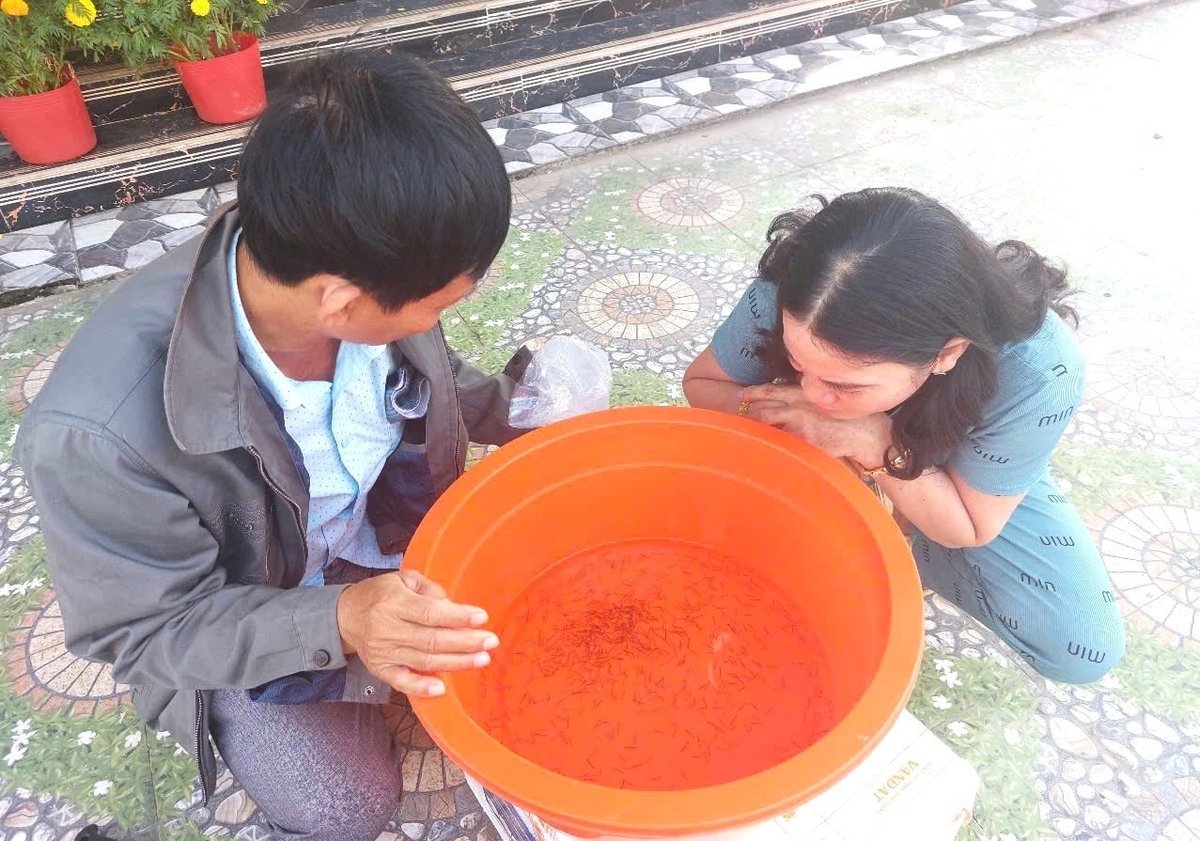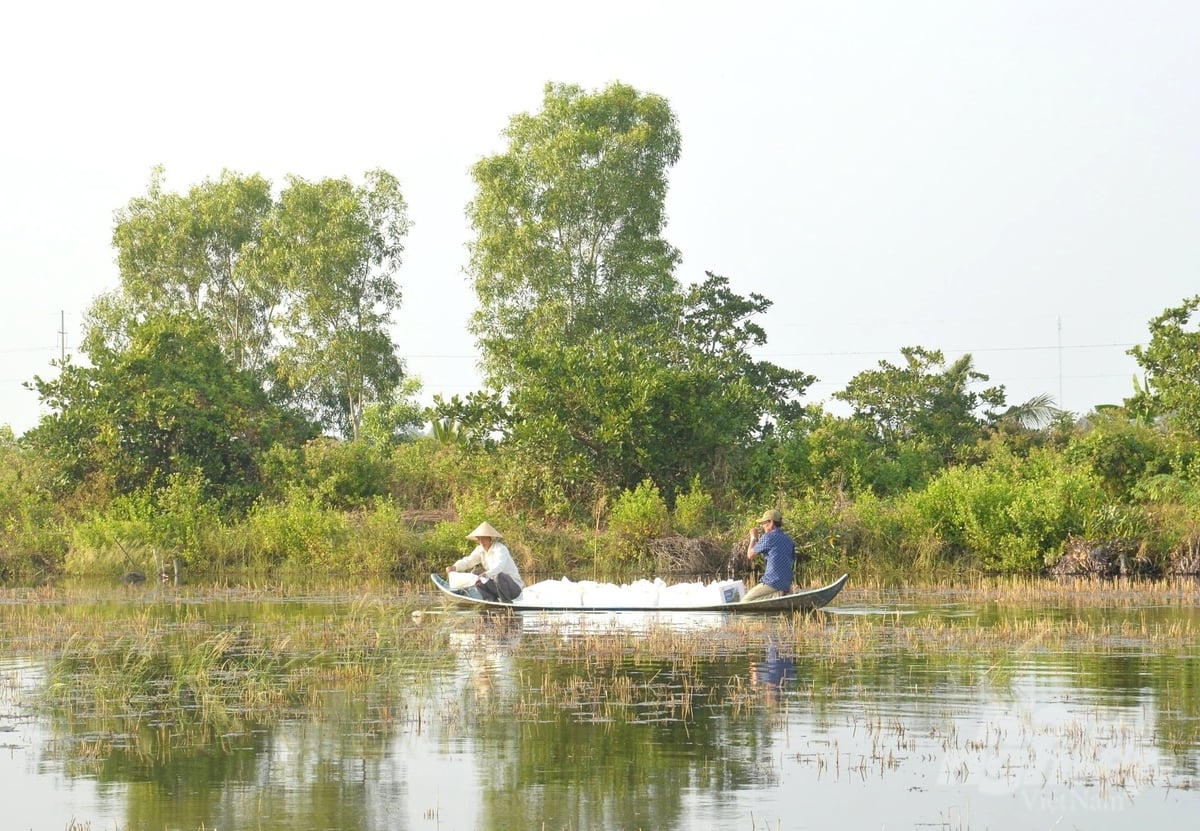November 19, 2025 | 14:55 GMT +7
November 19, 2025 | 14:55 GMT +7
Hotline: 0913.378.918
November 19, 2025 | 14:55 GMT +7
Hotline: 0913.378.918
As a province with a large area for brackish water shrimp farming, each year, farmers in Kien Giang and businesses in the aquaculture sector require billions of shrimp seeds. However, the shrimp seed production industry in Kien Giang is underdeveloped, only meeting a small portion of the demand for farming, with the remainder relying on shrimp seeds imported from neighboring provinces and the Central South region.

Farmers in Kien Giang will need about 17 billion shrimp seeds for farming in 2025, with the majority relying on shrimp seeds imported from outside the province. Photo: Trung Chanh.
Mr. Kim Hoang Thanh, Director of the Fisheries Sub-department of Kien Giang Province, said that in 2025, the agricultural sector has planned aquaculture with an area of 310.850 hectares, with an estimated total harvest of over 410.000 tons. Of this, brackish water shrimp farming will cover more than 137.000 hectares, with an estimated harvest of 145.000 tons. The farming methods include intensive and semi-intensive shrimp farming on 5.000 hectares, shrimp-rice farming on 107.000 hectares and improved extensive farming on over 22.000 hectares. For shrimp-rice farming, about 40.000 hectares will be used for farming giant freshwater prawn.
According to Mr. Thanh, with the planned farming area, the province's demand for shrimp seeds in 2025 is estimated at 16.6 billion pieces. This includes a need for nearly 6.1 billion black tiger shrimp seeds, over 9.2 billion whiteleg shrimp seeds, and 1.3 billion giant freshwater prawn seeds. However, local production can only meet less than 25% of the demand, with an estimated annual production of about 3.7 billion shrimp seeds. The most produced will be whiteleg shrimp, with an estimated 3.2 billion seeds produced, meeting about 30% of the demand. The production of black tiger shrimp is about 500 million seeds, and giant freshwater prawn production is just 30 million seeds.

Farmers mainly choose shrimp seeds based on their intuition, observing with their eyes if the shrimp swim quickly and react well to sound before purchasing. Photo: Trung Chanh.
Although it is a region with a significant demand for shrimp seeds, Kien Giang currently has very few enterprises capable of producing whiteleg shrimp seeds. Most facilities mainly produce shrimp seeds to meet the needs of their own industrial shrimp farming operations, and only sell the surplus in small quantities to serve the local community. Regarding black tiger shrimp seeds, the province has more than 20 production facilities, but they are small-scale and have limited production capacity.
Due to the heavy reliance on imported shrimp seeds from other provinces, Kien Giang has strongly developed the activity of breeding aquatic seeds, with over 200 facilities and farms focused on breeding shrimp, crabs, and various types of fish. It is expected that in 2025, these facilities will breed about 58.7 billion aquatic seeds. Among these, approximately 5.6 billion black tiger shrimp seeds, 6 billion whiteleg shrimp seeds, nearly 1.3 billion giant freshwater prawn seeds, 2.3 billion marine crab seeds, around 35 billion mollusk seeds, and nearly 8.6 billion fish seeds will be bred.
It has become a regular practice that after harvesting the rice crop on the land used for shrimp farming, Mr. Nguyen Van An (in Thuan Hoa commune, An Minh district, Kien Giang) waits for the tidal surge, with salty water flowing in from the sea, to pump onto the fields and prepare them. After the Lunar New Year holiday, when the shrimp seed suppliers resume operations, he contacts them to place an order for the seeds to release for farming.

Kien Giang is a province with a large area for shrimp-rice farming, and farmers often choose to buy packaged shrimp seeds because they trust the quality and reputation of the supplier. Photo: Trung Chanh.
Mr. An shared: "For our family’s 3-hectare shrimp farming area, I purchased 100.000 shrimp fry. These are black tiger shrimp that have been carefully bred. The company packed them in boxes and delivered them directly to our farm, which made the price higher, at 150 VND per shrimp. The total cost for purchasing these shrimp fry for this season amounted to 15 million VND (approximately 600 USD)". The box label claims that the shrimp fry are "free from 6 diseases such as stunted shrimp, white spot, yellow head, pancreatic atrophy, sporozoa, and liver necrosis".
However, Mr. An acknowledged that most farmers buy shrimp fry based on their personal instincts, typically by observing whether the shrimp swim actively and respond well to noise. TThey trust the marketing and advertisements provided by the suppliers. Farmers, however, rarely invest in the time or money needed to conduct laboratory tests to verify the quality of the incoming shrimp fry, despite the fact that this is a crucial factor that can determine whether the farming season is successful or not.
Farmers like Mr. An, who buy shrimp fry that are packed in branded boxes, are already considered to be in a better position compared to others. Many farmers, however, opt for shrimp fry that are packed in plastic bags, which are typically transported directly from the Central provinces and sold at the Saturday shrimp market in An Bien district. These shrimp are much cheaper, ranging from just a few dozen to 100 VND per shrimp. By the time morning breaks, trucks are already lined up at the market, and farmers begin arriving to inspect the shrimp in the bags. If they are satisfied with the quality, they finalize their purchase and take the shrimp home to their farms.
In An Bien District, it is projected that by 2025, there will be 22.000 hectares of shrimp-rice farming and 3.200 hectares of improved extensive shrimp farming. Mr. Trang Minh Tu, Head of the Department of Agriculture and Rural Development of An Bien District (formerly), stated that so far, farmers have already stocked more than 19.000 hectares of shrimp-rice, with the main species being black tiger shrimp. The remaining area is mainly in Đông Yên commune, where the saltwater comes in slowly due to its location deep in the inland area, so it is expected that by the end of February, the final stocking will be completed. As for the improved extensive shrimp farming area, farmers have already stocked shrimp fry.
According to Mr. Tu, the issues of poor shrimp fry quality, unfavorable weather conditions, and frequent disease outbreaks are always a major concern every time farmers enter a shrimp farming season.
In recent years, Kien Giang province has implemented a policy to support free disease testing for shrimp fry for households involved in extensive shrimp farming and shrimp-rice farming. However, very few farmers take shrimp samples for testing. Farmers explained that the trucks carrying shrimp fry deliver and then leave immediately to start another round of deliveries, so they do not wait around. Therefore, even if shrimp samples are taken for testing, by the time they return, the fry might have already been sold out. As a result, most farmers rely on intuition and visual observation to assess the quality of the shrimp fry. If they’re lucky, the farming goes well; if not, they simply have to restock and try again with a new batch.

Farmers have stocked shrimp fry for the new brackish water shrimp farming season, but they still carry the old worries: The quality of the shrimp fry, unfavorable weather conditions, and the risk of disease outbreaks. Photo: Trung Chanh.
Mr. Nguyen Dinh Xuyen, Deputy Director of the Animal Husbandry and Veterinary Sub-department of Kien Giang Province, stated that in 2024, the department conducted tests on 1.141 shrimp samples to check for diseases such as white spot syndrome (WSSV), acute hepatopancreatic necrosis (IHHNV), under-skin necrosis and hematopoietic organ issues (AHPND), and enterocytozoon hepatopenaei (EHP). As a result, 116 samples tested positive for common shrimp diseases, including 20 samples positive for WSSV, 11 for IHHNV, 41 for AHPND, and 44 for EHP.
In addition, the Sub-department regularly monitors the water environment and analyzes environmental indicators relevant to aquaculture, mainly brackish water shrimp farming. Specifically, they have analyzed the density of Vibrio bacteria, including total Vibrio and Vibrio parahaemolyticus, in 208 water samples for the manual water monitoring program at 16 points serving brackish water shrimp farming.
For the 2025 brackish water shrimp farming season, the Animal Husbandry and Veterinary Sub-department of Kiên Giang will continue to be tasked with testing shrimp fry samples to support the prevention and control of diseases in brackish water shrimp. It is expected that approximately 760 samples will be tested for WSSV, IHHNV, AHPND, and EHP. Based on these results, recommendations will be made to help farmers proactively choose quality shrimp fry, contributing to ensuring the targeted farming areas and yields.
Every time farmers begin a new shrimp farming season, they are again burdened with the same old worry: The quality of the shrimp fry. In shrimp farming, although the fry account for a small percentage of the total production cost, they are a crucial factor. The quality of the shrimp fry determines 70-80% of the success or failure of each farming season.
Translated by Phuong Linh
/2025/11/19/4847-1-093540_448.jpg)
(VAN) The Gia Lai Provincial People’s Committee had a working session with the delegation of the U.S. Department of Agriculture, the State of Idaho, and representatives of the State's leading enterprises.

(VAN) Ca Mau has a sufficient foundation to become a strong regional aquaculture center, where production integrates the economy, the environment, and the lives of the people.

(VAN) SEIKI Group envisions itself as a pioneer in the ‘dual transformation’ of digital technology and green industry, standing alongside the Government and Vietnamese businesses in their pursuit of sustainable development.

(VAN) The VNGEONET network affirms Viet Nam's progress in mastering digital space, providing a precise positioning data platform to serve socioeconomic development.
/2025/11/14/3247-1-184556_35.jpg)
(VAN) Thai Nguyen is methodically implementing digital transformation in the livestock sector, laying the foundation for a modern, transparent, and sustainable agriculture.

(VAN) The year 2025 marks 80 years of development of the Agriculture and Environment sector, a proud journey with significant progress in production, integration and sustainable growth.

(VAN) De Heus continues to steadfastly pursue sustainable development, building linked value chains with farmers and businesses in Viet Nam.